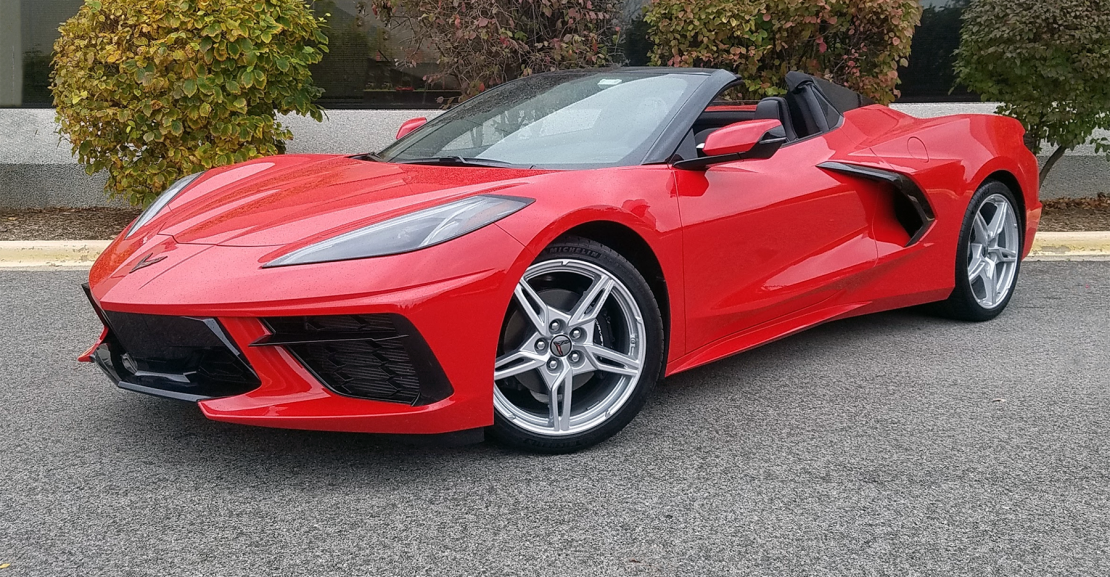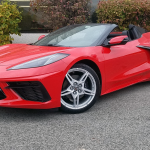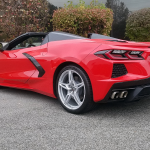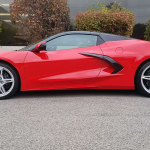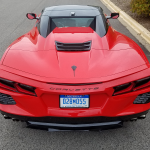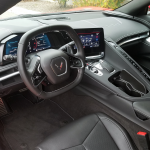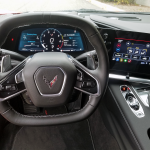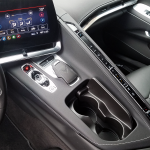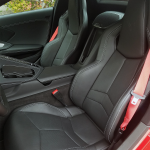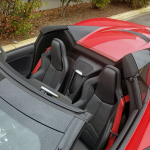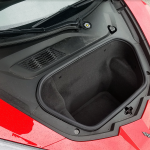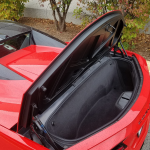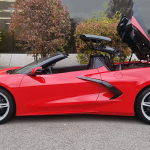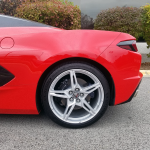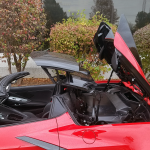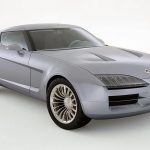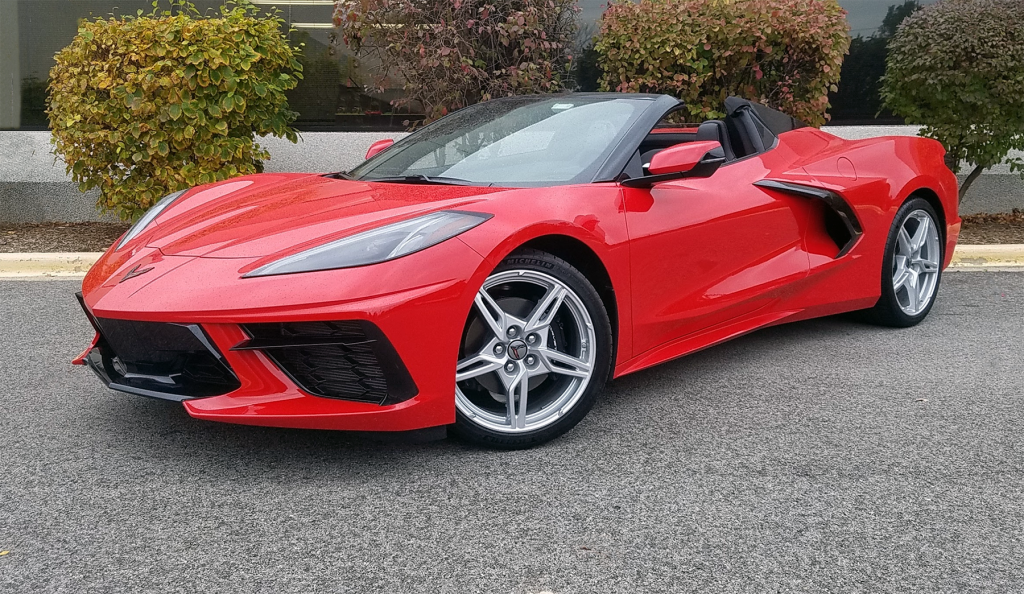
 2020 Chevrolet Corvette Stingray Convertible
2020 Chevrolet Corvette Stingray Convertible
Class: Premium Sporty/Performance Car
Miles driven: 97.1
Fuel used: 6.1 gallons
| CG Report Card | |
|---|---|
| Room and Comfort | B |
| Power and Performance | A |
| Fit and Finish | B |
| Fuel Economy | C+ |
| Value | A |
| Report-card grades are derived from a consensus of test-driver evaluations. All grades are versus other vehicles in the same class. Value grade is for specific trim level evaluated, and may not reflect Consumer Guide's impressions of the entire model lineup. | |
| Big & Tall Comfort | |
| Big Guy | C- |
| Tall Guy | C- |
| Big & Tall comfort ratings are for front seats only. "Big" rating based on male tester weighing approximately 350 pounds, "Tall" rating based on 6'6"-tall male tester. | |
| Drivetrain | |
| Engine Specs | 495-hp 6.2L |
| Engine Type | V8 |
| Transmission | 8-speed automatic |
| Drive Wheels | RWD |
Real-world fuel economy: 15.8 mpg
Driving mix: 90% city, 10% highway
EPA-estimated fuel economy: 15/27/19 (city, highway, combined)
Fuel type: Premium gas recommended
Base price: $66,400 (not including $1095 destination charge)
Options on test vehicle: Carbon Flash painted nacelles and convertible top ($1295), performance exhaust ($1195), Torch Red seat belts ($395)
Price as tested: $70,380
Quick Hits
The great: Unbeatable level of performance for the dollar; broad range of available features and appearance options offer excellent customizability
The good: Respectable ride quality for a high-performance supercar
The not so good: Poor rear visibility; low-slung seats can make entry/exit tricky; headroom isn’t as good as Corvette coupe; some enthusiasts will bemoan lack of a manual transmission
More Corvette price and availability information
John Biel
The tale of the midengine Chevrolet Corvette reads like some epic quest of legend—searches for fountains of youth and caves of gold that drove obsessed adventurers for lifetimes but were in vain. Long before he formally became Corvette’s chief engineer in 1967, the famed Zora Arkus-Duntov began pushing for the car’s engine to be moved from the nose to behind the driver, as in some of the world’s greatest sports and GT machines, but his bosses wouldn’t budge. Long after he died in 1996, the layout stayed the same as ever. In the meantime, the automotive press lavished torrents of ink on a host of teaser designs and concepts, each one surely the midengine ’Vette at last—only they never were. The “middie” became a myth that just grew.
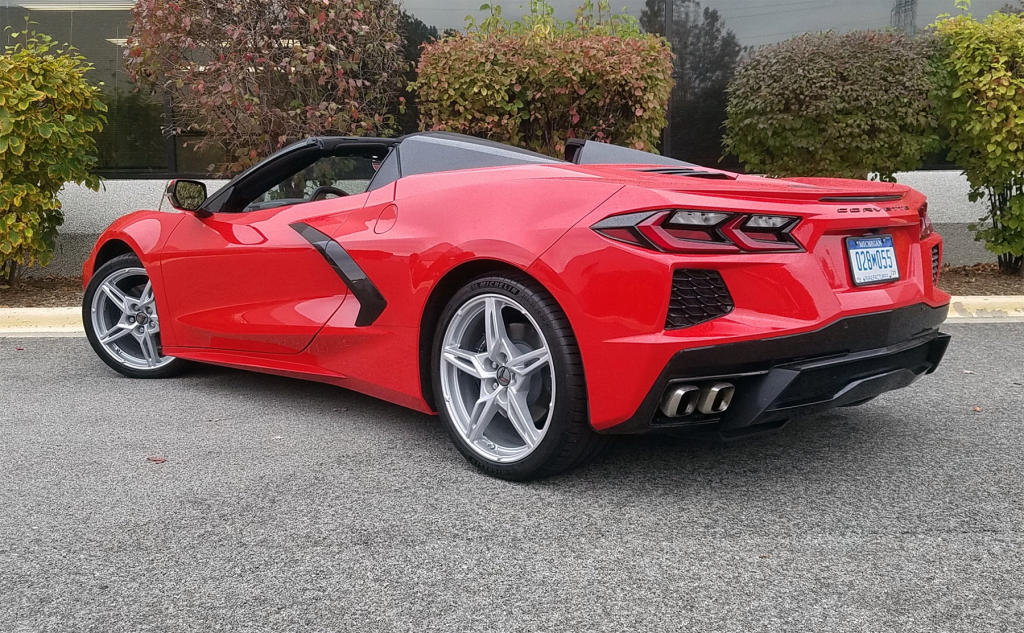
Then one day it happened. In July 2019, Chevrolet validated the latest speculation and confirmed the “C8” generation of “America’s sports car” due for 2020 would indeed flip the script of its architecture. Even then, it barely came off. First, a strike delayed the start of production until February. Then in March, not even two weeks after the car went on sale, the COVID-19 pandemic shut down the Bowling Green, Kentucky, assembly plant after not quite 2700 C8 Stingrays had been made.
Production eventually resumed, with a convertible joining the initially released coupe. Consumer Guide got to drive examples of both within weeks of each other, and our review of them starts with the convertible.
Test Drive: 2020 BMW M8 Competition Convertible
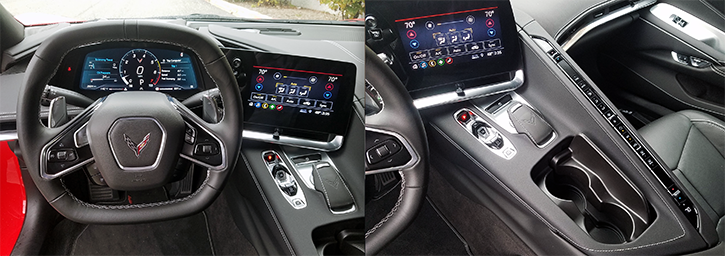
The Torch Red tester was the open car at its most basic, the 1LT equipment level. If you want things like heated and ventilated seats, navigation, wireless charging for smartphones, or blind-spot and rear cross-traffic monitoring, you won’t find them here at a $67,495 starting price (with delivery). What does come for that money is a 6.2-liter V8 and 8-speed dual-clutch automatic transmission; mechanical limited-slip differential; rear park assist; heated power exterior mirrors; LED headlamps; 8-way power-adjustable bucket seats; leather-wrapped steering wheel; power tilt/telescoping steering column; dual-zone automatic climate control; rear-camera mirror; Chevrolet Infotainment 3 system with 8-inch touchscreen, Apple CarPlay/Android Auto smartphone compatibility, and Bluetooth audio streaming; Bose 10-speaker audio; satellite radio; keyless entry and starting; and remote starting. A modest option load—Carbon Flash-painted bodyside nacelles and roof, horsepower-hiking performance exhaust, and seatbelts that matched the body color—resulted in a midengine-exotic “spyder” at the price of a decked-out pickup truck: $70,380.
Test Drive: 2020 Mercedes-AMG GT C Roadster
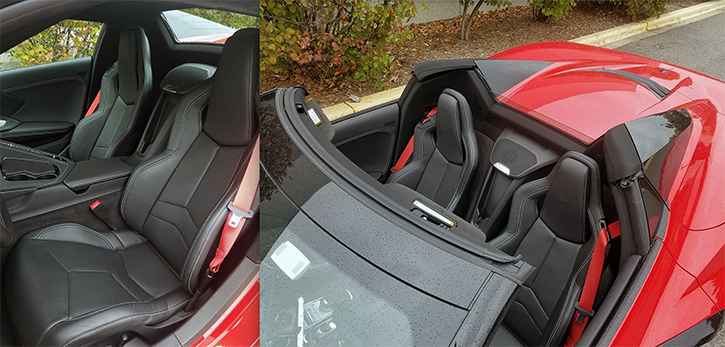
The new layout enables better weight distribution for improved performance potential. The complete rethinking of this performance icon results in a car that is 182.3 inches long and 76.1 inches wide on a 107.2-inch wheelbase, numbers that are all greater than those of the C7 ’Vette. An aggressive, curvaceous profile pushes the cockpit further forward. Gone are the days of peering over the rolling fiberglass hills of Corvetteland beyond the windshield. Fender tops are visible, but now with no need to accommodate an engine, the rest of the shorter front drops away, revealing nothing but road ahead. A longer deck and huge, severe midbody air vents make it clear where the powerplant is now.
Test Drive: 2021 Lexus LC 500 Convertible
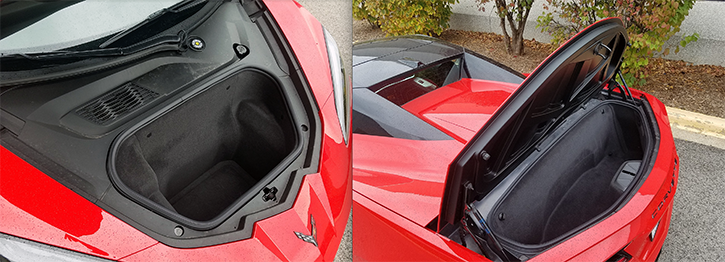
That mill is the 6.2-liter LT2 “small-block” V8. Bestowed with low-restriction intake and exhaust systems and new dry-sump oiling that allows the engine to sit lower in the chassis, it makes 490 horsepower at 6450 rpm and 465 lb-ft of torque at 5150 rpm in standard tune. However, the performance exhaust option nudges output to 495 horsepower and 470 lb-ft—enough, Chevy says, to go from rest to 60 mph in as little as 2.9 seconds.
More Corvette news and reviews
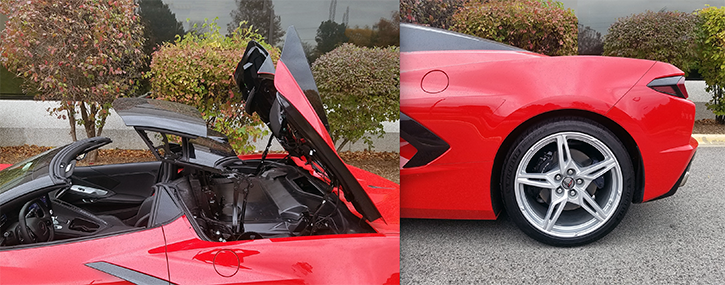
The automatic trans is the only way to go. Like other extreme performance car these days, there is no manual transmission option, but responsive paddle shifters let drivers pick their spots if they choose. Four main driving modes are summoned by a console dial: “Tour,” “Weather,” “Sport,” and “Track” that influence shift points, steering effort, engine sound, and braking feel. This reviewer did his expressway and surface-street driving in Tour and Sport. Tour is great for everyday driving and plenty fast. Acceleration in Sport feels lots more eager—and its sounds like it, too. The note from the performance exhaust varies with mode, dropping into a lower, louder register in Sport. Two new configurable settings are “MyMode” (to mix elements from the other modes for everyday driving preferences) and “Z Mode” (for access to additional high-performance engine, transmission, and steering settings for track use).
1986: Year of Corvette Acronyms

EPA fuel-mileage estimates are 15 mpg in city driving, 27 mpg on the highway, and 19 combined. Our 97-mile stint with 90 percent city-type driving averaged a 15.8 mpg–on par with the EPA numbers. However, it was interesting to actually see it go bad during a miles-long crawl due to a stalled truck during a morning commute. A trick little fuel-efficiency bar graph in the colorful 12-inch instrument array showed our real-time fuel economy dropping precipitously during a miles-long crawl due to a stalled truck during a morning commute. The graph display shot way up once we cleared this and could drive freely because cylinder deactivation kicked in and ran the car on just four cylinders.
Ride is incredibly comfortable, and mostly unfazed by bumps. When it does encounter them, the rigid body structure resists rattling and shaking. Cornering is utterly flat with an almost oiled ease, and steering is extremely responsive and direct. All-season performance tires hug 19×8.5-inch front and 20×11-inch rear wheels.
The open Stingray’s power retractable hardtop opens or closes in 16 seconds, and can do so on the move at up to 30 mph. The roof panel mates with “buttresses” on the rear deck that hamper over-the-shoulder sightlines, negating one benefit of a top-down convertible. The vertical rear window can be lowered for some fresh-air feel with the top still up. Though not a particularly large opening, the straight-back view seems a little better than the view out the coupe’s drastically sloped backlight.
A high, rising beltline blunts that elbow-on-the-door impulse that comes so naturally on a nice day in a convertible. You’ll want to keep all appendages in the cabin, where the materials are better than in recent Corvettes, but the “Great Wall” between driver and passenger that holds the many buttons for climate controls is an odd thing that will take getting used to. Cabin storage is skimpy. At 12.6 cubic feet, there’s more total luggage space than in the C7 convertible—but it is split between front and rear compartments.
America’s sports car has become America’s exotic. Incredibly, it remains as realistically attainable as ever. That’s legendary.
Test Drive: 2020 Aston Martin Vantage Coupe
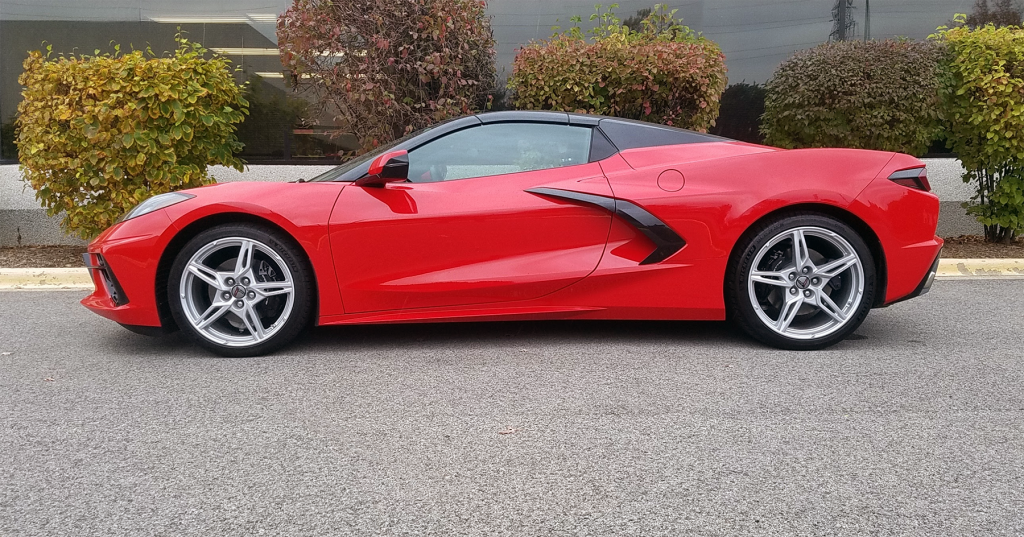
(Click below for enlarged images)
Listen to the very entertaining Consumer Guide Car Stuff Podcast
2020 Chevrolet Corvette Convertible Gallery
2020 Chevrolet Corvette Convertible

